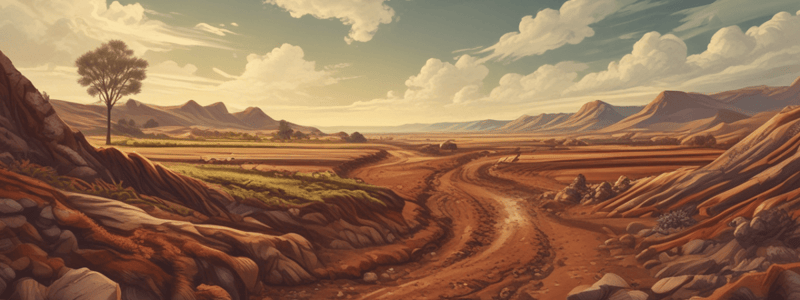Podcast
Questions and Answers
What is the primary factor that determines soil texture and water-holding capacity?
What is the primary factor that determines soil texture and water-holding capacity?
- Particle size (correct)
- Organic matter content
- Drainage
- Soil structure
Which of the following processes breaks down minerals in soil, releasing nutrients and forming new minerals?
Which of the following processes breaks down minerals in soil, releasing nutrients and forming new minerals?
- Erosion
- Sedimentation
- Compaction
- Weathering (correct)
What is the primary effect of compaction on soil?
What is the primary effect of compaction on soil?
- Reduced pore space and limited root growth (correct)
- Increased pore space and water infiltration
- Increased microbial activity and nutrient availability
- Improved soil structure and fertility
Which of the following methods is used to investigate soil texture?
Which of the following methods is used to investigate soil texture?
What is the primary effect of organic matter loss on soil?
What is the primary effect of organic matter loss on soil?
What is the primary difference between compacted and uncompacted soil in terms of total pore space?
What is the primary difference between compacted and uncompacted soil in terms of total pore space?
What is the primary effect of erosion on soil?
What is the primary effect of erosion on soil?
What is the primary difference between compacted and uncompacted soil in terms of capillarity and infiltration rate?
What is the primary difference between compacted and uncompacted soil in terms of capillarity and infiltration rate?
Flashcards are hidden until you start studying
Study Notes
Physical Features of Soil
- Particle size determines soil texture and water-holding capacity.
- Soil texture is defined by the relative proportions of sand, silt, and clay.
- Drainage is influenced by the physical features of soil.
Soil Structure and Compaction
- Soil structure is the organization of soil particles into aggregates.
- Compaction reduces pore space, limits root growth, and decreases water infiltration.
- Compacted soil has lower total pore space, reducing air and water-holding capacity.
Impact of Soil Degradation
- Organic matter loss reduces soil fertility, decreases water-holding capacity, and disrupts soil structure.
- Erosion removes topsoil, decreases nutrient availability, and increases sedimentation in water bodies.
- Sedimentation deposits eroded soil particles in water bodies, affecting aquatic ecosystems.
Weathering and Soil Formation
- Weathering breaks down minerals in soil, releasing nutrients and forming new minerals.
Investigating Soil Texture
- Sedimentation can be used to observe settling rates of sand, silt, and clay particles in water.
- Soil sieves separate soil particles based on size (sand, silt, clay).
- Hand testing involves feeling soil texture and cohesiveness by hand (sandy, loamy, clayey).
Water Movement in Soil
- Compacted soil has reduced capillarity and infiltration rates due to restricted pore space.
- Uncompacted soil has higher capillarity and infiltration rates, allowing for better water movement.
Studying That Suits You
Use AI to generate personalized quizzes and flashcards to suit your learning preferences.




